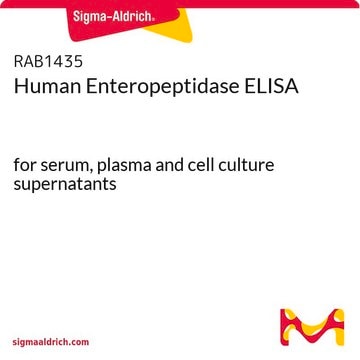50611
Atto 700 maleimide
BioReagent, suitable for fluorescence, ≥90% (coupling to thiols)
Se connecterpour consulter vos tarifs contractuels et ceux de votre entreprise/organisme
About This Item
Produits recommandés
Gamme de produits
BioReagent
Pureté
≥90% (coupling to thiols)
Fabricant/nom de marque
ATTO-TEC GmbH
Fluorescence
λex 645 nm; λem 715 nm in 0.1 M phosphate pH 7.0
Adéquation
suitable for fluorescence
Température de stockage
−20°C
Application
Atto 700 belongs to a new generation of fluorescent labels. The dye is designed for application in the area of life science, e.g. labeling of DNA, RNA or proteins. Maleimides are well suited for coupling to thiol groups. This is similar to iodacetamides, but maleimides do react more thiol selective. They do not show significant reaction with histidine or methionine. Hydrolysis of maleimides to a mixture of isomeric nonreactive maleamic acids can compete significantly with thiol modification, particularly above pH 8. Maleimides may be used for labeling of amines, which usually requires a higher pH than reaction of maleimides with thiols.
Informations légales
This product is for Research use only. In case of intended commercialization, please contact the IP-holder (ATTO-TEC GmbH, Germany) for licensing.
Code de la classe de stockage
11 - Combustible Solids
Classe de danger pour l'eau (WGK)
WGK 3
Point d'éclair (°F)
Not applicable
Point d'éclair (°C)
Not applicable
Équipement de protection individuelle
Eyeshields, Gloves, type N95 (US)
Certificats d'analyse (COA)
Recherchez un Certificats d'analyse (COA) en saisissant le numéro de lot du produit. Les numéros de lot figurent sur l'étiquette du produit après les mots "Lot" ou "Batch".
Déjà en possession de ce produit ?
Retrouvez la documentation relative aux produits que vous avez récemment achetés dans la Bibliothèque de documents.
Multicolour single molecule imaging in cells with near infra-red dyes.
Tynan, C.J., et al.
PLoS ONE, 4, e36265-e36265 (2012)
Daniel Riester et al.
Bioorganic & medicinal chemistry letters, 19(13), 3651-3656 (2009-05-22)
Histone deacetylases reside among the most important and novel target classes in oncology. Selective lead structures are intensively developed to improve efficacy and reduce adverse effects. The common assays used so far to identify new lead structures suffer from many
Judith E Berlier et al.
The journal of histochemistry and cytochemistry : official journal of the Histochemistry Society, 51(12), 1699-1712 (2003-11-19)
Amine-reactive N-hydroxysuccinimidyl esters of Alexa Fluor fluorescent dyes with principal absorption maxima at about 555 nm, 633 nm, 647 nm, 660 nm, 680 nm, 700 nm, and 750 nm were conjugated to antibodies and other selected proteins. These conjugates were
Jan Vogelsang et al.
Photochemical & photobiological sciences : Official journal of the European Photochemistry Association and the European Society for Photobiology, 8(4), 486-496 (2009-04-02)
The role and interplay of triplet states and radical ion states in single-molecule fluorescence spectroscopy has recently been elaborated providing us with new insights into the photophysics and photobleaching pathways of fluorescent dyes. Adjustment of fluorophore redox properties in combination
Patricia Haus et al.
Journal of biomolecular screening, 16(10), 1206-1216 (2011-10-27)
Histone deacetylases (HDACs) are important epigenetic factors regulating a variety of vital cellular functions such as cell cycle progression, differentiation, cell migration, and apoptosis. Consequently, HDACs have emerged as promising targets for cancer therapy. The drugability of HDACs has been
Notre équipe de scientifiques dispose d'une expérience dans tous les secteurs de la recherche, notamment en sciences de la vie, science des matériaux, synthèse chimique, chromatographie, analyse et dans de nombreux autres domaines..
Contacter notre Service technique




